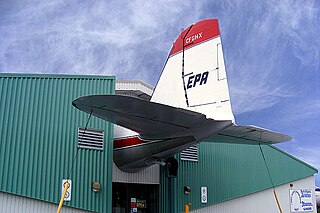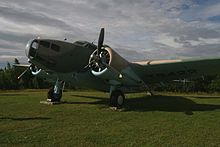Gander is a town located in the northeastern part of the island of Newfoundland in the Canadian province of Newfoundland and Labrador, approximately 40 km (25 mi) south of Gander Bay, 100 km (62 mi) south of Twillingate and 90 km (56 mi) east of Grand Falls-Windsor. Located on the northeastern shore of Gander Lake, it is the site of Gander International Airport, once an important refuelling stop for transatlantic aircraft. The airport is still a preferred emergency landing point for aircraft facing on-board medical or security issues.
RAF Ferry Command was the secretive Royal Air Force command formed on 20 July 1941 to ferry urgently needed aircraft from their place of manufacture in the United States and Canada, to the front line operational units in Britain, Europe, North Africa and the Middle East during the Second World War.

The Lockheed Hudson is a light bomber and coastal reconnaissance aircraft built by the American Lockheed Aircraft Corporation. It was initially put into service by the Royal Air Force shortly before the outbreak of the Second World War and primarily operated by it thereafter. The Hudson was a military conversion of the Model 14 Super Electra airliner, and was the first significant aircraft construction contract for Lockheed — the initial RAF order for 200 Hudsons far surpassed any previous order the company had received.
A transatlantic flight is the flight of an aircraft across the Atlantic Ocean from Europe, Africa, South Asia, or the Middle East to North America, Latin America, or vice versa. Such flights have been made by fixed-wing aircraft, airships, balloons and other aircraft.

Gander International Airport is located in Gander, Newfoundland and Labrador, Canada, and is operated by the Gander International Airport Authority. Canadian Forces Base Gander shares the airfield but is a separate entity from the airport. The airport is sometimes referred to as the "Crossroads of the World", and is classified as an international airport by Transport Canada.

Eastern Provincial Airways (EPA) was an airline that operated in Atlantic and eastern Canada. At its peak, the carrier operated jet service with Boeing 737-200 aircraft connecting many communities that today only have scheduled passenger flights provided by 18-seat commuter turboprop aircraft. The airline traces its history from Maritime Central Airways (MCA) from 1961. It merged with CP Air to form Canadian Pacific Air Lines in 1986.

The Lockheed Model 14 Super Electra was an American civil passenger and cargo aircraft built by the Lockheed Aircraft Corporation during the late 1930s. An outgrowth of the earlier Model 10 Electra, the Model 14 was also developed into larger, more capable civil and military versions.

St. John's International Airport is located 3 nautical miles northwest of St. John's, Newfoundland and Labrador, Canada. It serves the St. John's metropolitan area and the Avalon Peninsula. The airport is part of the National Airports System, and is operated by St. John's International Airport Authority Inc.

Canadian Forces Base Greenwood, or CFB Greenwood, is a Canadian Forces Base located 1.5 nautical miles east of Greenwood, Nova Scotia. It is primarily operated as an air force base by the Royal Canadian Air Force and is one of two bases in the country using the CP-140 Aurora and CP-140A Arcturus anti-submarine/maritime patrol and surveillance aircraft. Its primary RCAF lodger unit is 14 Wing, commonly referred to as 14 Wing Greenwood.

Canadian Forces Base Gander, is a Canadian Forces base located in Gander, Newfoundland and Labrador. It is operated as an air force base by the Royal Canadian Air Force and is home to search and rescue operations that cover a vast swath of the western North Atlantic and southern Arctic and a Canadian Coastal Radar station amongst other things. It is home to 9 Wing Gander.
The British Purchasing Commission was a United Kingdom organisation of the Second World War. Also known at some time as the "Anglo-French Purchasing Board", it was based in New York City, where it arranged the production and purchase of armaments from North American manufacturers. After the 1940 French Surrender it became the 'British Purchasing Commission'. The Commission was also responsible for taking over orders that had originally been placed by France, Belgium, and later by Norway, after the capitulation of those countries.

The North Atlantic Aviation Museum is an aviation museum located in the town of Gander, Newfoundland and Labrador, Canada.

Diverted is a 2009 CBC made-for-TV miniseries. The film was directed by Alex Chapple based on the screenplay by Tony Marchant. Diverted is a fictionalized account inspired by what actually happened to the people of Gander, Newfoundland, and the passengers and crews on the airliners diverted by the Federal Aviation Administration (FAA) during the 9/11 attacks in Operation Yellow Ribbon.
No. 231 Squadron RAF was a squadron of the Royal Air Force between 1918 and 1946, active in both World War I and World War II in various roles.

The North Atlantic air ferry route was a series of Air Routes over the North Atlantic Ocean on which aircraft were ferried from the United States and Canada to Great Britain during World War II to support combat operations in the European Theatre of Operations (ETO).

No. 113 Squadron was a Royal Canadian Air Force squadron that was active during the Second World War. It was originally formed as an Army Co-operation squadron and then a fighter squadron before being disbanded in 1939 and then reformed in 1942. It was primarily used in an anti-submarine role and was based on the east coast of Canada and Newfoundland. The squadron flew the Lockheed Hudson and Lockheed Ventura before disbanding on 10 August 1944.

No. 17 Group RAF was a group of the Royal Air Force which was operational in the last year of the First World War, and throughout the Second World War.

Ferry Pilot is a film produced in 1942 by Stuart Legg and Ross McLean for the National Film Board of Canada series The World in Action, in cooperation with the United Kingdom Ministry of Information and the Crown Film Unit. The film has an unaccredited narration by broadcaster Lorne Greene.

On April 25, 1944, a Royal Air Force Liberator B Mark VI en route to Britain via Gander, Newfoundland crashed into the Griffintown neighborhood in downtown Montreal, Quebec minutes after taking off from Dorval Airport. The five-member crew and ten civilians on the ground were killed, and a large fire destroyed at least 10 homes.

On 11 September 1990, a Faucett Perú Boeing 727 airliner, registered OB-1303, disappeared in an area of the Atlantic Ocean approximately 180 miles southeast of Cape Race, Newfoundland, Canada. The aircraft was being ferried back from Malta to Peru after having been leased to Air Malta, and had six crewmembers on board as well as ten passengers consisting of airline employees and their families. The last contact with the crew was a distress message stating that the aircraft had run out of fuel and that they were preparing to ditch. The aircraft was hundreds of miles off course at the time. Nothing more was ever heard from the flight, and no trace of the aircraft or any of the occupants has since been found.















